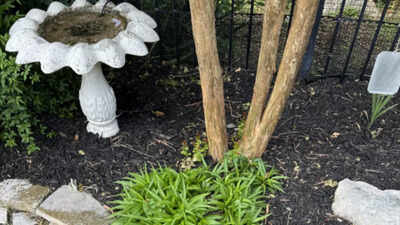ARTICLE AD BOX

Source: Reddit/@KRothbauer
Spotting a rattlesnake isn’t usually a challenge, its patterned scales and signature rattle make its presence known. But sometimes, nature’s camouflage works so well that danger hides in plain sight.
That’s exactly what happened to a homeowner who stumbled upon a five-foot rattlesnake coiled in their backyard creek bed, blending so perfectly into its surroundings that it nearly went unnoticed.The person, who shared their experience in a Reddit thread, said they were gardening in the dry creek bed behind their home when they realized a rattlesnake was just three feet away. To their surprise, the snake remained silent.
*“Not a peep!”* they wrote, noting that the reptile had even buried its head, making it even harder to identify.What looked like an ordinary patch of mulch and greenery turned out to be a deadly hiding spot. At first glance, the small creek bed appeared undisturbed, with only a few weeds breaking through. But hidden in the scene was what the Redditor jokingly called a little "dangernoodle.” Even other users admitted they struggled to see it in the photo.
“Can you spot the snake?” the poster challenged. For those who couldn’t, they offered a hint: "Check the greenery?”

Source: Reddit/@KRothbauer
If you managed to find the rattlesnake coiled up in the middle of the green plant, you'd have sharp eyes. If not, you’re not alone—many others missed it too.One user who saw where the snake was hiding commented, "Damn that danger noodle is about take out some unsuspecting ankles!"Another hilariously said, "Can't see it. Need you to pick it up and put it on my hand for better view. "A third user asked, "That's a big one toooooo!!! It didn't rattle at all at you?" The user did not mention where he is from, but most rattlesnakes are found in arid and rocky regions of the Americas, particularly in the Southwestern United States and northern Mexico. Their range extends from southern Canada to central Argentina, but the highest abundance and diversity of species occur in the desert environments of North America. Arizona has the most species in the US, and they can be found in diverse habitats like rocky areas, prairies, marshes, and forests, often near open, rocky spaces.



.png)
.png)
.png)
















 9 hours ago
4
9 hours ago
4








 English (US) ·
English (US) ·